This gadget is primarily positioned as a professional device, for mass screening, however, as the developer Etta says, it is also useful for home use.
According to the creator, at home, the analyzer can be shown "
for control after operations, in patients with kidney stones during the prevention of re-stone formation, in pregnant women with the threat of infections, gestosis, in children with urinary bladder reflux, chronic pyelonephritis, with diagnostics and etc. "

We decided to look closely at how this works.
The device "
ETTA AMP-01 " outwardly represents something like an enlarged mobile phone with a sliding part for test strips.

It is quite simple to manage, here is a localized menu. Getting started is reduced to pressing the power button, after which the system “self-test” starts and the user is transferred immediately to the analysis mode.
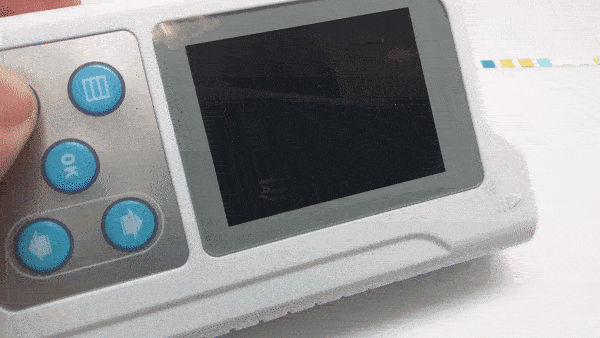 The device analyzes:
The device analyzes:- Glucose (GLU)
- Bilirubin (BIL)
- Relative Density (SG)
- pH (PH)
- Ketone bodies (KET)
- Hidden blood (BLD)
- Protein (PRO)
- Urobilinogen (URO)
- NITRITES (NIT)
- Leukocytes (LEU)
- Ascorbic Acid (VC)
The test method that underlies the instrument is photometric, and the instrument itself is used to read results from the test strip without subjective errors in color perception. In other words, test strips remain the key link in the work model.

The test strip is “arranged” in an understandable way and consists of several markers that, under the influence of the reagent, will be painted in one or another color depending on the results.

In other words, the first stage of work can be characterized as “visual”. The user, following the recommendations, applies a urine sample to the test strip, and then compares the results with the color instruction on the can.

Then reads with the analyzer. Once again, the device in this case serves for the correct objective analysis of colors and provides data storage.
To perform the analysis, it is necessary to install a test strip in a special retractable container.
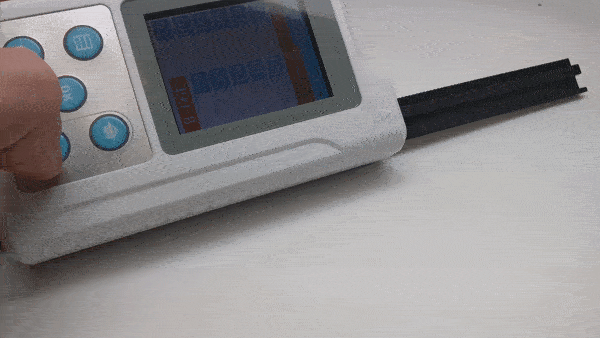
Then use the control button down to remove the container inside and click "OK". The container with the strip leaves the device again and the countdown starts: the
time for conducting one analysis is 60 seconds .
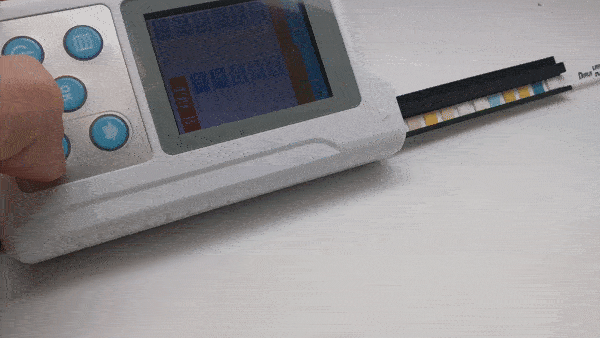
Once the process is complete, you will see the results of the study.

The built-in memory of the device allows you to store 500 measurements. All of them will be structured in a special section of the menu - "Analyzes".
 Etta menu
Etta menuThe analyzer has its own menu, the control inside of which is carried out with the switch buttons and the “OK” button, which is responsible for “decision making”. To get to the menu, with the gadget on, you must hold the first or top left button.

Here you can select a measurement system, set the date, language, and also go to advanced settings, including device calibration. By default, the device is calibrated under the attached test strips, so no additional updating of the parameters is required.
You can also return to the previous items by pressing the “Menu” button.
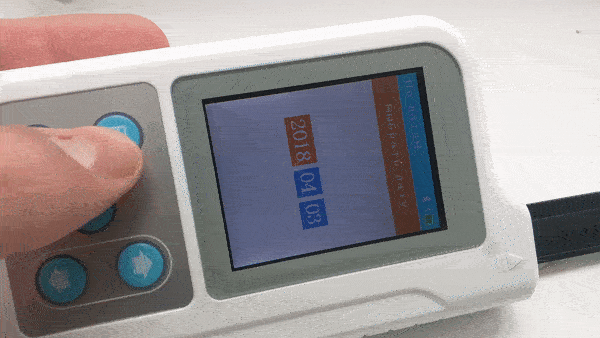 How to prepare and carry out urine analysis using Etta
How to prepare and carry out urine analysis using EttaIt is recommended to thoroughly mix the sample before conducting the test. The study must be conducted within an hour after collection.
Immersion strips carried out for 2-3 seconds. Then, after waiting for the time recommended on the can with strips (60 seconds), you need to compare the result with the color chart.
A urine sample that has been stored for not more than 4 hours is required for the analysis. Immerse the test strip in a urine sample, then remove excess fluid with a tissue and place it in a pull-out compartment. Further, as already demonstrated above, push the strip inside and press "OK".
Note that all recommendations and precautions, as well as thresholds of sensitivity and other important information are fully presented in the accompanying instructions.
Work with the applicationThe device can send data to the NetHealth app for
IOS and
Android .
When you synchronize data with the application, the data from the Etta device will be deleted!

In the application, you will find a conveniently structured list of analyzes with expanded access to each analysis.
According to the informativeness of the test strips are somewhat inferior to the clinical overall urine analysis. For comparison:

By accuracy:
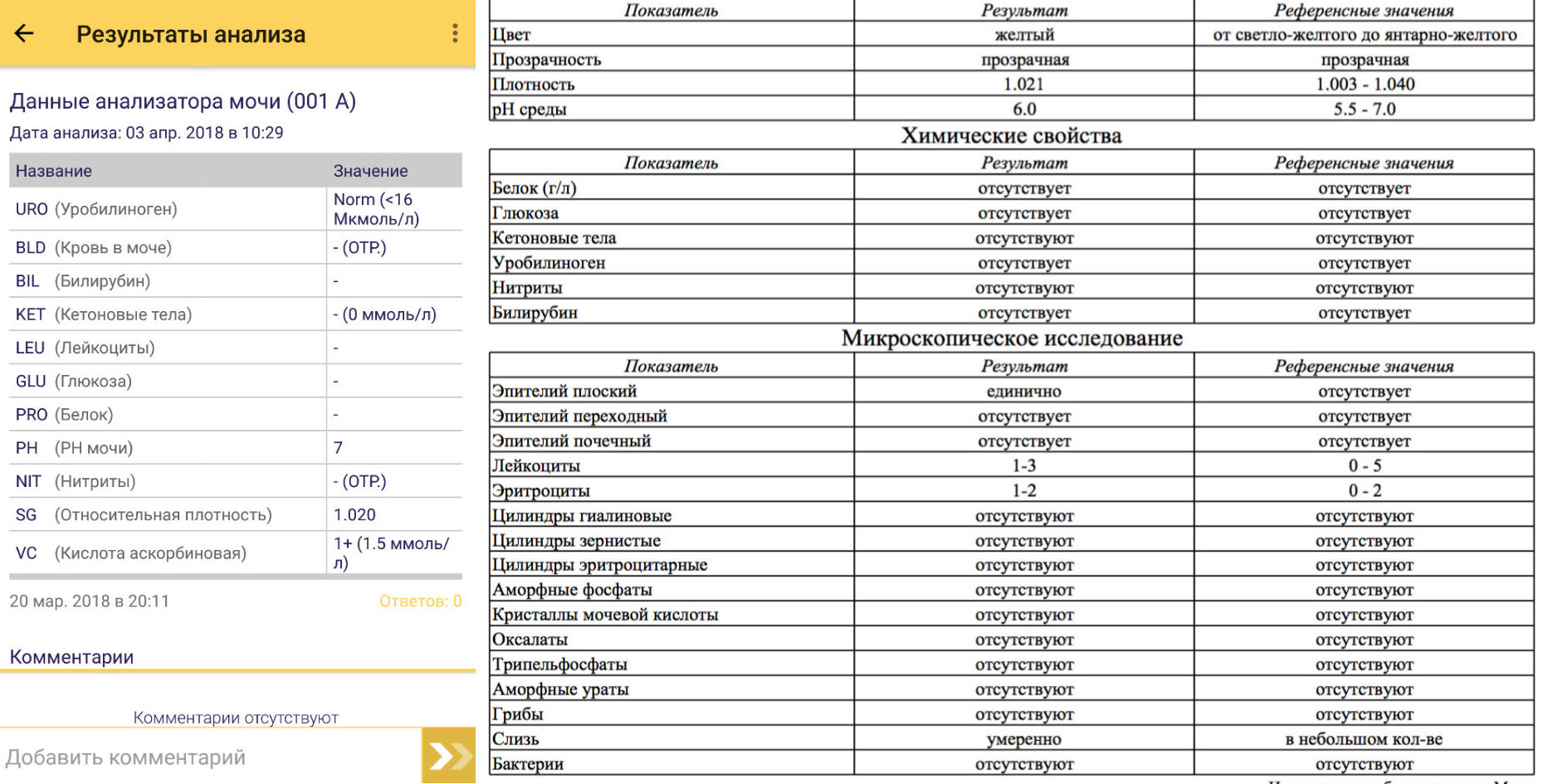
The device "ETTA AMP-01" has RU as a medical product.
 Device configuration
Device configuration"ETTA AMP-01" is supplied in a plastic case, inside which there is a bank of strips, a power adapter, instructions and recommendations for the product.

The device has a microUSB connector at the bottom.

The device operates from a built-in battery with a capacity of 1900 mAh, which will provide up to 250 measurements. Charging time to full volume is about 4 hours. The battery status is displayed on the device display.
From the back of the analyzer Reset button.

- Device weight - 180 grams
- Dimensions - 126 x 73.5 x 30
- Screen - LCD, 320 x 240
Currently, there are several similar competitive products, against which ETTA AMP-01 stands out according to a number of parameters, including ease of use, synchronization with a smartphone and a lower price.
| Laura Smart (Erba Lachema, Czech Republic) | DocUReader (77 Elektronka, Hungary) | HandUReader (77 Elektronka, Hungary) | ETTA AMP-01 |
| The number of measured parameters | eleven | eleven | eleven | eleven |
| Technology | photometry | photometry | photometry | photometry |
| Performance | 60 tests per hour | 40 tests per hour | 50 tests per hour | 60 tests per hour |
| Memory | 360 results | 1000 results | 200 results | 500 results |
| Control | touch screen | touch screen | touch screen | push button |
| Mobile app | not | not | not | Yes |
| PC connection | Yes | Yes | Yes | Yes |
| Dock station | built-in printer | built-in printer | yes built-in printer | not |
| Sizes, mm | 230 x 127 x 110 | 250 x 120 x 70 | 480 x 290 x 165 | 126 x 73.5 x 30 |
| Weight, g | 800 | 850 | 850 (400 without docking station) | 180 |
| price, rub. | 49,925 | 36,135 | 50,800 | 32 500 |
A sourceResultsAs a result, this time I would like to offer several theses on why we should pay attention to the indicators analyzed by the device.
 Colour
ColourThe normal color of urine is “straw”, yellow, and any shades may indicate some deviations. Reddish urine may indicate, for example, glomerulonephritis. The admixture of blood can indicate acute cystitis, renal colic, arouse suspicion of cancer. It should not be forgotten that urine shades can also be given to food products.
TransparencyNormal urine is clear. Turbid - may be an indication of the presence of salts, any bacteria, mucus.
ProteinNormal urine protein is either absent or detectable.
his tracks. Occurrence can be caused by urinary tract infection, kidney tumor, nephropathy, and other negative factors.
GlucoseNorm is the absence of glucose in the urine. Most often, the presence of her in the volume indicates diabetes. At the same time, glucose can also appear after ingestion of large amounts of carbohydrates, burns and severe injuries. Glucose can also indicate acute pancreatitis and myocardial infarction.
Ketone bodiesIn a healthy person, 20–30 mg of ketones are released per day. Ketonuria is a bad sign and may indicate acute pancreatitis, diabetes. It also occurs in coma and precomatose states.
Nitrite (bacteriuria)Normally they are not. Detection of nitrites in the urine indicates the presence of urinary tract infection.
Hidden blood (hemoglobin, myoglobin)Hidden blood in the urine can be detected in urolithiasis, tumors of the urogenital system, cystitis, pyelonephritis, hemolytic anemia, and some others.
Leukocytes (leukocyte esterase, leukocyturia, pyuria)Leukocyte esterase is an enzyme produced by leukocytes. Under conditions of improper storage of urine, leukocytes are rapidly destroyed, therefore, the definition of leukocyte esterase is a more reliable diagnostic method.
Leukocyturia is the most characteristic symptom of an infectious-inflammatory process in the kidneys and urinary tract.
It should be noted that leukocyte esterase can be determined even before the clinical manifestations of the disease:
- Acute or chronic cystitis
- Acute or chronic pyelonephritis
- Urethritis
- Prostatitis
Specific gravityMeasurement of the parameter allows to judge the ability of the kidneys to concentrate urine. Reduced ability may indicate renal failure. The proportion can be increased in case of toxicosis in pregnant women, a large loss of fluid, uncompensated diabetes mellitus, heart failure and kidney disease.
pH (acidity)Normally, the reaction of urine is slightly acid (pH 5.0 - 7.0). It depends on many factors: age, diet, body temperature, exercise, kidney condition, etc.
The lowest pH values are in the morning on an empty stomach and the highest after meals. When using predominantly meat food, the reaction is more acidic, and when consumed with vegetable food, it is alkaline.
It is very important to monitor the urine pH in urolithiasis. The reaction of urine determines the possibility and nature of the formation of stones: uric acid stones are more often formed at a pH below 5.5, oxalate at 5.5–6.0, phosphate at pH 7.0– 7.8.
The cost of a kit with 100 test strips is 32,000 rubles . For those who are interested in this device, we offer a discount of 10% - ETTAAMP . Coupon valid until April 6.